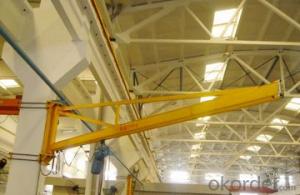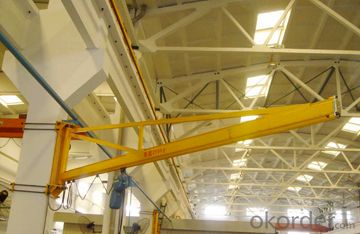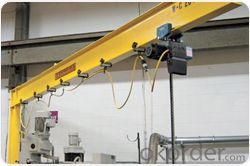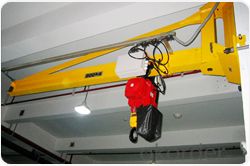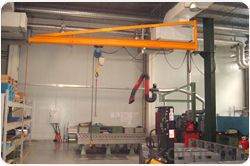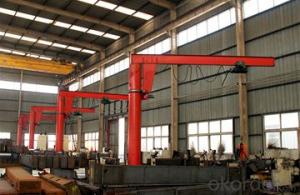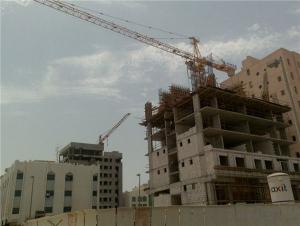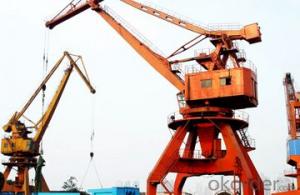Light Duty 180 Degree Wall Mounted Jib Crane
- Loading Port:
- Shanghai
- Payment Terms:
- TT OR LC
- Min Order Qty:
- 1 unit
- Supply Capability:
- 20 unit/month
OKorder Service Pledge
OKorder Financial Service
You Might Also Like



BZ model column style jib crane is recently developed mid-light lifting equipment, its unique mechanism, reliable safety is featured high performance, energy and time saving, flexible characters. It could be operated in 3-D space, esp short distance, densely lifting situations to show its advantages compared with common lifting equipment, widely used in workshop, warehouse, yard and other fixed situations.
Features:
No ground standing column.
Rotation: 180 degrees.
Save more space on the ground.
Simple installation
Easy operation
High efficiency
Nice appearance
Technical Data:
Type | BZ0.5 | BZ1 | BZ2 | BZ3 | BZ5 | |
Lift Capacity (t) | 0.5 | 1 | 2 | 3 | 5 | |
Max. Lift Height(m) | 3 | 3 | 3 | 4 | 4 | |
Slew Angle(0) | 360 | 360 | 360 | 360 | 360 | |
Lift Speed (m/min) | Normal | 8 | 8 | 8 | 8 | 8 |
Slow | 0.8 | 0.8 | 0.8 | 0.8 | 0.8 | |
Level Travel Speed (m/min) | 20 | 20 | 20 | 20 | 20 | |
Slew Angular Speed (r/min) | 1 | 0.75 | 0.7 | 0.9 | 0.6 | |
- Q: Is it possible to use a building hoist for material transportation in both indoor and outdoor environments, especially in confined spaces within industrial zones?
- <p>Yes, building hoists can be used both indoors and outdoors in industrial areas, even with limited space. They are designed for material transportation during construction and are adaptable to various environments. For indoor use, hoists are often enclosed to protect from weather and debris. Outdoors, they may require additional weatherproofing. In confined spaces, compact and tower hoists are used to save space. However, safety regulations and space constraints must be considered to ensure proper installation and operation.</p>
- Q: This question asks for an explanation on how to operate a winch, specifically in the context of a building hoist.
- <p>To use a winch, particularly a building hoist, follow these steps: Ensure the winch is securely anchored and the cable is in good condition. Attach the load to the hook, ensuring it's balanced. Turn the winch handle clockwise to lift the load; counterclockwise to lower it. Always keep tension on the cable to prevent it from slacking. Use a tag line to guide the load horizontally. Never exceed the winch's load limit. Regularly inspect the winch and cable for wear and tear. Always have a spotter to assist and communicate during the operation. Safety is paramount, so never leave the winch unattended while the load is in the air.</p>
- Q: What's going on with the decline in construction lift
- Check whether the brake work is valid.Check to see if there is any problem with holding the brake.
- Q: The user is asking if it's possible for them to fix their own building hoist without professional assistance.
- <p>While it is technically possible to repair your own building hoist, it's generally not recommended unless you have specific expertise in hoist maintenance and repair. Building hoists are complex mechanical systems that require knowledge of safety regulations and proper repair techniques. Attempting repairs without proper training can lead to accidents or further damage. It's best to hire a professional who is familiar with the specific model and has the necessary certifications to ensure the hoist is safe and functioning correctly.</p>
- Q: This question asks for safety guidelines and procedures to be followed when operating a building hoist.
- <p>To use a building hoist safely, follow these guidelines: Ensure the hoist is regularly inspected and maintained by qualified personnel. Never exceed the hoist's load capacity. Keep the hoist and its surroundings clean and free from debris. Always use safety hooks and never leave the hoist unattended when in use. Ensure all safety features, such as limit switches and emergency stop buttons, are functioning correctly. Train operators on the proper use of the hoist and adhere to all manufacturer's instructions. Never use a hoist if it shows signs of damage or malfunction. Always wear appropriate personal protective equipment (PPE) when operating a hoist.</p>
- Q: How many meters or how many layers should the construction elevator be installed?
- Construction elevator is also called construction lifter, alias outdoor elevator or people dual-purpose ladder. The country is not clear how many meters or how many layer must be used, but in some coastal developed cities are now more than 30 meters using construction elevator, some cities also issued relevant rules more than 30 meters must use construction lifter, gantry and hoist is no longer used.
- Q: This question asks if a building hoist can be utilized for lifting both light and heavy objects.
- <p>Yes, a building hoist can be used for lifting both light and heavy objects. It is designed to handle a wide range of weights, depending on its capacity. Building hoists are engineered to lift materials such as bricks, concrete, and steel beams during construction. However, it's crucial to ensure that the hoist's lifting capacity is not exceeded to avoid accidents. Always check the manufacturer's specifications and safety guidelines before lifting any object with a building hoist.</p>
- Q: This question asks for a comparison of vertical and horizontal lifting in the context of building hoists, highlighting their distinct characteristics.
- <p>Vertical lifting in a building hoist refers to the movement of materials directly up or down, which is essential for transporting goods between different floors or levels of a building under construction. Horizontal lifting, on the other hand, involves moving materials across a horizontal plane, which is useful for moving items along a floor or between different parts of a construction site. Vertical lifting is typically more common in hoists due to the nature of building construction, requiring frequent vertical transport. Horizontal lifting is less common but can be implemented with specialized equipment or by combining vertical and horizontal movements. The choice between vertical and horizontal lifting depends on the specific requirements of the construction project and the layout of the site.</p>
- Q: Construction site construction elevator and tower crane, which unit security check and acceptance?
- Different but most likely is the construction elevator
- Q: This question asks whether a building hoist can be utilized to lift various objects with differing weights and dimensions.
- <p>Yes, building hoists are designed to lift a variety of objects with different weights and sizes. They are versatile and adjustable, allowing for the transportation of materials such as bricks, concrete, and equipment. However, each hoist has a specific weight capacity that must not be exceeded. It's crucial to ensure that the objects being lifted are within the hoist's capacity and that the hoist is properly configured for the size and shape of the objects to ensure safety and efficiency.</p>
Send your message to us
Light Duty 180 Degree Wall Mounted Jib Crane
- Loading Port:
- Shanghai
- Payment Terms:
- TT OR LC
- Min Order Qty:
- 1 unit
- Supply Capability:
- 20 unit/month
OKorder Service Pledge
OKorder Financial Service
Similar products
Hot products
Hot Searches
Related keywords
